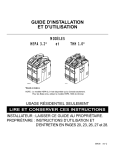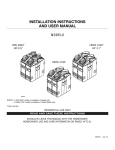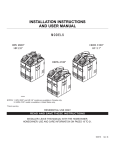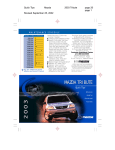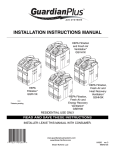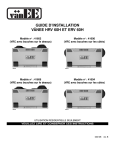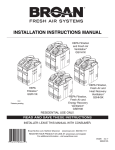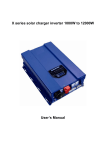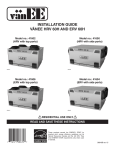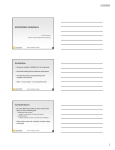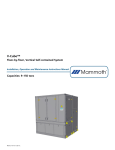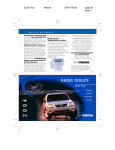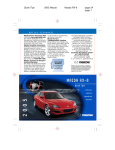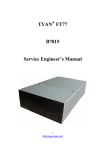Download Installation Manual
Transcript
INSTALLATION INSTRUCTIONS AND USER MANUAL H E PA 3 . 2 * VB0049 MODELS and THH 1.0* VB0058 *Patents pending NOTE: HEPA 3.2 model available in Canada only. For United States, use Venmar HEPA 1000 model. RESIDENTIAL USE ONLY READ AND SAVE THESE INSTRUCTIONS INSTALLER: LEAVE THIS MANUAL WITH CONSUMER. HOMEOWNER: USE AND CARE INFORMATION ON PAGES 22, 25, 28, 29 and 30. 05438 rev E . ABOUT THIS MANUAL First, we want to congratulate you on your purchase of this excellent unit which will allow you and your family to enjoy clean and healthy air throughout your home for years to come! The illustrations in this publication are typical ones. Some details of your unit may be slightly different than the ones shown. Please take note that this manual uses the following symbols to emphasize particular information: 0 ! WARNING Identifies an instruction which, if not followed, might cause serious personal injuries including possibility of death. CAUTION Denotes an instruction which, if not followed, may severely damage the unit and/or its components. NOTE: Indicates supplementary information needed to fully complete an instruction. We welcome any suggestions you may have concerning this manual and/or the unit, and we would appreciate hearing your comments on ways to better serve you. Please contact us at the address listed in the warranty text, at the end of this manual. ABOUT THESE UNITS 0 ! WARNING TO REDUCE THE RISK OF FIRE, ELECTRIC SHOCK, OR INJURY TO PERSON(S) OBSERVE THE FOLLOWING: 1. This unit is intented for residential installation only. 2. Installation must be done in accordance with all applicable codes and standards, including fire-rated construction codes and standards. 3. This unit is not designed to provide combustion and/or dilution air for fuel-burning appliances. 4. Do not install in a cooking area or connect directly to an appliance. 5. Before replacing filters, servicing or cleaning unit, disconnect the power cord from electrical outlet. 6. When cutting or drilling into wall or ceiling, do not damage electrical wiring or other hidden utilities. 7. Do not use this unit with any solid-state speed control device other than wall controls #04862 or #05439 (for HEPA 3.2 unit) and #04391 or #05536 (for THH 1.0 unit) (all control devices sold separately). 8. This unit must be grounded. The power supply cord has a 3-prong grounding plug for your personal safety. It must be plugged into a mating 3-prong grounding receptacle, grounded in accordance with the national electrical code and local codes and ordinances. Do not remove the ground prong. Do not use an extension cord. 9. This unit must be installed in a weatherized location out of direct sunlight and protected from the elements. 10. Use this unit only in the manner intended by the manufacturer. If you have questions, contact the manufacturer at the address or telephone number listed in this document. 11. For general filtration and ventilation use only. Do not use to exhaust hazardous or explosive materials and vapors. CAUTION 1. Intended for residential installation only in accordance with the requirements of NFPA 90B. 2. Do not run any air ducts directly above or closer than 2 ft (0.61 m) to any furnace or its supply plenum, boiler, or other heat producing appliance. 2.1 For HEPA 3.2 unit only, if a duct has to be connected to the furnace return plenum, it must be connected not closer than 2 ft (0.61 m) from this plenum connection to the furnace. 2.2 For THH 1.0 unit only, if a duct has to be connected to the furnace return plenum, it must be connected not closer than 9’10” (3 m) from this plenum connection to the furnace. 3. The ductwork is intended to be installed in compliance with all local and national codes that are applicable. 4. To avoid prematurate clogged filters, turn OFF the unit during construction or renovation. 5. Please read the unit specification label on the product for further information and requirements. -2- TABLE OF CONTENTS 1. TECHNICAL DATA . . . . . . . . . . . . . . . . . . . . . . . . . . . . . . . . . . . . . . . . . . . . . . . . . . . . . . . . . .4 1.1 1.2 1.3 1.4 2. Performance Charts . . . . . . . . . . . . . . . . . . . . . . . . . . . . . . . . . . . . . . . . . . . . . . . . . . . . . . . . . . .4 Specifications . . . . . . . . . . . . . . . . . . . . . . . . . . . . . . . . . . . . . . . . . . . . . . . . . . . . . . . . . . . . . . . .4 Dimensions . . . . . . . . . . . . . . . . . . . . . . . . . . . . . . . . . . . . . . . . . . . . . . . . . . . . . . . . . . . . . . . . . .5 Mounting and Servicing Consideration . . . . . . . . . . . . . . . . . . . . . . . . . . . . . . . . . . . . . . . . . . . . .5 HEPA 3.2 UNIT INSTALLATION . . . . . . . . . . . . . . . . . . . . . . . . . . . . . . . . . . . . . . . . . . . . . . . .7 2.1 2.2 Inspect the Content of the Box . . . . . . . . . . . . . . . . . . . . . . . . . . . . . . . . . . . . . . . . . . . . . . . . . . . .7 Locating and Mounting the Unit . . . . . . . . . . . . . . . . . . . . . . . . . . . . . . . . . . . . . . . . . . . . . . . . . . .7 2.3 2.4 2.5 2.6 2.7 2.8 Mount the Ports on the Unit . . . . . . . . . . . . . . . . . . . . . . . . . . . . . . . . . . . . . . . . . . . . . . . . . . . . .7 Mount the Nameplate on the Unit . . . . . . . . . . . . . . . . . . . . . . . . . . . . . . . . . . . . . . . . . . . . . . . . .7 How to Hang the Unit . . . . . . . . . . . . . . . . . . . . . . . . . . . . . . . . . . . . . . . . . . . . . . . . . . . . . . . . .7-8 Planning of the Ductwork . . . . . . . . . . . . . . . . . . . . . . . . . . . . . . . . . . . . . . . . . . . . . . . . . . . . . . .9 Calculating the Duct Size . . . . . . . . . . . . . . . . . . . . . . . . . . . . . . . . . . . . . . . . . . . . . . . . . . . . . . . .9 Installing Ductwork and Registers . . . . . . . . . . . . . . . . . . . . . . . . . . . . . . . . . . . . . . . . . . . . . . 10-11 3. THH 1.0 UNIT INSTALLATION . . . . . . . . . . . . . . . . . . . . . . . . . . . . . . . . . . . . . . . . . . . . . . . .12 3.1 3.2 3.3 3.4 3.5 3.6 3.7 3.8 3.9 3.10 3.11 4. Inspect the Content of the Box . . . . . . . . . . . . . . . . . . . . . . . . . . . . . . . . . . . . . . . . . . . . . . . . . . .13 Locating and Mounting the Unit . . . . . . . . . . . . . . . . . . . . . . . . . . . . . . . . . . . . . . . . . . . . . . . . . .13 Mount the Ports on the Unit . . . . . . . . . . . . . . . . . . . . . . . . . . . . . . . . . . . . . . . . . . . . . . . . . . . . .13 Mount the Nameplate on the Unit . . . . . . . . . . . . . . . . . . . . . . . . . . . . . . . . . . . . . . . . . . . . . . . .13 How to Hang the Unit . . . . . . . . . . . . . . . . . . . . . . . . . . . . . . . . . . . . . . . . . . . . . . . . . . . . . . .13-14 Planning of the Ductwork . . . . . . . . . . . . . . . . . . . . . . . . . . . . . . . . . . . . . . . . . . . . . . . . . . . . . . .15 Calculating the Duct Size . . . . . . . . . . . . . . . . . . . . . . . . . . . . . . . . . . . . . . . . . . . . . . . . . . . . . . .15 Installing Ductwork and Registers . . . . . . . . . . . . . . . . . . . . . . . . . . . . . . . . . . . . . . . . . . . . . . 16-17 Installing Insulated Flexible Duct . . . . . . . . . . . . . . . . . . . . . . . . . . . . . . . . . . . . . . . . . . . . . . .18-19 Installing Dual Exterior Hood . . . . . . . . . . . . . . . . . . . . . . . . . . . . . . . . . . . . . . . . . . . . . . . . . 20-21 Connecting the Drain . . . . . . . . . . . . . . . . . . . . . . . . . . . . . . . . . . . . . . . . . . . . . . . . . . . . . . . . . 21 CONTROLS . . . . . . . . . . . . . . . . . . . . . . . . . . . . . . . . . . . . . . . . . . . . . . . . . . . . . . . . . . . . .22 4.1 4.2 4.3 4.4 4.5 4.6 5. Main Switch . . . . . . . . . . . . . . . . . . . . . . . . . . . . . . . . . . . . . . . . . . . . . . . . . . . . . . . . . . . . . . . 22 Optional Wall Controls . . . . . . . . . . . . . . . . . . . . . . . . . . . . . . . . . . . . . . . . . . . . . . . . . . . . . . . 22 Dimensions . . . . . . . . . . . . . . . . . . . . . . . . . . . . . . . . . . . . . . . . . . . . . . . . . . . . . . . . . . . . . . . . 22 Installation of the Optional Wall Control . . . . . . . . . . . . . . . . . . . . . . . . . . . . . . . . . . . . . . . . 22-24 Operating the #04862 or #05439 Control . . . . . . . . . . . . . . . . . . . . . . . . . . . . . . . . . . . . . . . . . 25 Operating the #04391 or #05536 Control . . . . . . . . . . . . . . . . . . . . . . . . . . . . . . . . . . . . . . . . . 25 WIRING DIAGRAMS . . . . . . . . . . . . . . . . . . . . . . . . . . . . . . . . . . . . . . . . . . . . . . . . . . . . . . .26 5.1 5.2 6. HEPA 3.2 Wiring Diagram . . . . . . . . . . . . . . . . . . . . . . . . . . . . . . . . . . . . . . . . . . . . . . . . . . . . . .26 THH 1.0 Wiring Diagram . . . . . . . . . . . . . . . . . . . . . . . . . . . . . . . . . . . . . . . . . . . . . . . . . . . . . . .26 BALANCING PROCEDURE (THH 1.0 6.1 6.2 6.3 6.4 7. ONLY) What You Need to Balance the Unit . Preliminary Stages to Balance the Unit Installation of Flow Collar . . . . . . . . . Balancing Procedure . . . . . . . . . . . . . . . . . . . . . . . . . . . . . . . . . . . . . . . . . . . . . . . . . . . . . . . . . . . . . . . . . . . .27 . . . . . . . . . . . . . . . . . . . . . . . . . . . . . . . . . . . . . . . . . . . . . . . . . . . . . . . . . . . . . . . . . . . . . . . . . . . . . . . . . . . . . . . . . . . . . . . . . . . . . . . . . . . . . . . . . . . . . . . . . . . . . . . . . . . . . . . . . . . . . . .27 . . . . . . .27 . . . . . . .27 . . . . . . .27 MAINTENANCE . . . . . . . . . . . . . . . . . . . . . . . . . . . . . . . . . . . . . . . . . . . . . . . . . . . . . . . . . . .28 7.1 7.2 7.3 8. 9. 10. Semi-Annual Maintenance (Essential) . . . . . . . . . . . . . . . . . . . . . . . . . . . . . . . . . . . . . . . . . . . .28-29 Annual Maintenance . . . . . . . . . . . . . . . . . . . . . . . . . . . . . . . . . . . . . . . . . . . . . . . . . . . . . . . . . .29 Master Reset . . . . . . . . . . . . . . . . . . . . . . . . . . . . . . . . . . . . . . . . . . . . . . . . . . . . . . . . . . . . . . .29 PARTS ORDERING CHART . . . . . . . . . . . . . . . . . . . . . . . . . . . . . . . . . . . . . . . . . . . . . . . . . . .30 TROUBLESHOOTING . . . . . . . . . . . . . . . . . . . . . . . . . . . . . . . . . . . . . . . . . . . . . . . . . . . . . . .30 WARRANTY . . . . . . . . . . . . . . . . . . . . . . . . . . . . . . . . . . . . . . . . . . . . . . . . . . . . . . . . . . . . .30 -3- 1. TECHNICAL DATA 1.1 PERFORMANCE CHARTS HEPA 3.2 FILTRATION AIRFLOW External static Pressure (inch of water) 1.20 1.00 Low speed (Normal mode) 0.80 0.60 0.40 High speed (Boost mode) 0.20 0.00 100 125 VG0064 150 175 200 225 250 275 300 325 Airflow (Cubic Feet per Minute) THH 1.0 VENTILATION PERFORMANCE LOW SPEED NET SUPPLY AIR FLOW l/s cfm m 3/h 23 48 82 21 45 76 19 40 68 l/s 24 23 20 GROSS AIR FLOW SUPPLY EXHAUST cfm m 3/h l/s cfm m 3/h 51 87 26 54 92 48 82 23 49 83 43 73 19 41 70 HIGH SPEED EXT STATIC PRESSURE Pa in.w.g 50 .2 100 .4 150 .6 200 .8 250 1.00 NET SUPPLY AIR FLOW l/s cfm m 3/h 47 100 170 44 93 158 41 86 146 37 79 134 34 73 124 l/s 50 46 42 39 36 GROSS AIR FLOW SUPPLY EXHAUST cfm m 3/h l/s cfm m 3/h 105 178 50 106 180 98 165 46 99 167 90 155 43 91 155 83 141 38 80 136 76 129 33 71 121 External static Pressure (inch of water) EXT. STATIC PRESSURE Pa in.w.g. 50 .2 100 .4 150 .6 1.20 High Speed Supply (cfm) Exhaust (cfm) 1.00 0.80 0.60 Low Speed Supply (cfm) Exhaust (cfm) 0.40 0.20 0.00 0 THH 1.0 ENERGY PERFORMANCE SUPPLY TEMPERATURE C° F° HEATING 0 +32 0 +32 0 +32 -25 -13 COOLING +35 +35 1.2 +95 +95 l/s 20 40 60 80 100 120 Gross Airflow (Cubic Feet per Minute) POWER SENSIBLE APPARENT CONSUMED RECOVERY SENSIBLE m 3/h WATTS EFFICIENCY EFFECTIVENESS NET AIR FLOW cfm 24 35 44 16 52 74 94 35 87 126 158 59 –– –– –– –– –– –– 116 147 189 114 63 59 57 58 85 75 75 95 TOTAL RECOVERY EFFICIENCY Not tested SPECIFICATIONS Model Weight Performance Oval Ports Installation: Suspension Electrical Supply Power Consumption (“Boost”) Power Consumption (“Normal”) HEPA 3.2 THH 1.0 34 lbs (15.4 kg) 41.2 lbs (18.7 kg) 180 cfm low speed, 50 cfm low speed, 320 cfm high speed 90 cfm high speed fit two 8” round ducts fit four 5” or 6” round ducts 4 Chains, springs and hooks (included with the unit) 120 Volts AC, 60 Hz 170 Watts 192 Watts 105 Watts 110 Watts NOTE : All specifications are subjected to change without notice. -4- 1. TECHNICAL DATA (CONT’D) 1.3 DIMENSIONS HEPA 3.2 THH 1.0 29'' (737 mm) 30.2'' (767 mm) 17.8'' (452 mm) 17.8'' (452 mm) 22.9'' (581 mm) 22.9'' (581 mm) VK0047 VK0049 FRONT VIEW 1.4 MOUNTING • TOP VIEW AND FRONT VIEW TOP VIEW SERVICING CONSIDERATIONS The two following pictures are showing the minimum clearance needed to open the door completely. 8” (203 mm) 22” (559 mm) 22.5” (572 mm) 15.75” (400 mm) VD0117 VD0116 NOTES: 1. A minimum of 8” (203 mm) clearance from any obstruction on top of the unit is required for the ductwork radius turn. 2. A grounded three-prong electrical outlet has to be available within 3 feet from the unit. -5- -6- VH0038 SEE SECTION 2.8.2 INSTALLATION TYPE SHOWN: CENTRAL DRAW POINT 2. HEPA 3.2 UNIT INSTALLATION VC0054 HANG THE UNIT VI0013 SEE SECTION 2.5 HOW TO VD0129 SECTION 4: CONTROL AND VH0047 SEE SECTION 2.8.3 RETURN-RETURN INSTALLATION VH0037 SEE SECTION 2.8.1 STAND ALONE INSTALLATION SEE SECTIONS 2.7 AND 2.8 DUCT SIZE, INSTALLING DUCTWORK REGISTERS 2. HEPA 3.2 UNIT INSTALLATION (CONT’D) 2.1 INSPECT THE CONTENT OF THE BOX 0 ! WARNING To avoid risk of suffocation, discard the plastic bag wrapping the unit. • Inspect the exterior of the unit for shipping damage. Ensure there is no damage to the door, door latches, main switch, etc. CAUTION Remove the cardboard strip inside the unit. • Inspect the interior of the unit for damage. Ensure the blower assembly, insulation, prefilter, HEPA filter, etc. are all intact. • If the unit was damaged during shipping, contact your local distributor. 2.2 LOCATING AND MOUNTING THE UNIT Choose an appropriate location for the unit. • Within an area of the house where the ambient temperature is between 10°C (50°F) and 30°C (86°F) (basement, furnace room, closet, etc.). • So as to provide easy access to the interior of the unit, for filter maintenance. • Away from hot chimneys and other fire hazards. 2.3 MOUNT THE PORTS ON THE UNIT Mount the 8” (HEPA 3.2 unit) oval ports on the top of the unit using the screws provided in the hardware box (4 screws #8 x 3/4” long per port). 1 NOTE: If an optional wall control has to be installed, do not install the front oval port (1) at this time. VO0045 2.4 MOUNT THE NAMEPLATE ON THE UNIT Select your company nameplate (Venmar or vänEE) and snap it on the unit door. Discard the other nameplate. 2.5 VO0049 HOW TO HANG THE UNIT Use the 4 chains and springs in the hardware pack provided with the unit. According to your needs, you can install the unit either in vertical or horizontal position. VERTICAL POSITION HORIZONTAL POSITION (LEFT SIDE) VD0130 HORIZONTAL VD0131 VD0129 -7- POSITION (RIGHT SIDE) 2. HEPA 3.2 UNIT INSTALLATION (CONT’D) 2.5 HOW TO HANG THE UNIT (CONT’D) • Turn the switch knob to OFF position in order to unlock the door. Unlatch the door and open it. A NOTE: If preferred, the door can be removed. First, remove the stopper (A) located on the right side of the door hinge, then, slide the door out of its hinge. VD0170 • Using a screwdriver, remove the 2 retaining screws of the front plate and carefully remove the front plate from the unit. VO0019 • Insert the 4 hooks in the square holes and fix them to the unit using 4 screws #8 - 32 x 3/4”. NOTE: If an optional wall controll has to be installed, go to Section 4.0 on pages 20 to 22. If not, continue the installation. • Reinstall the front plate, the door and the door stopper. VO0020 • Hang the unit to the floor joist, using 4 #8 x 1 1/2” screws, 4 chains and 4 spings. See illustration beside. VD0132 -8- 2. HEPA 3.2 UNIT INSTALLATION (CONT’D) 2.6 PLANNING OF THE DUCTWORK CAUTION Do not attempt to recover the exhaust air from a dryer or a range hood. This would cause clogging of the filters. • Follow the instructions in Section 2.7 below to determine the appropriate duct diameters for your system. Do not use branch lines smaller than 6”ø (152 mm) diameter. • Do not use wall cavities as ducts. • Keep it simple. Plan for a minimum of bends and joints. • Do not ventilate crawl spaces or cold rooms. • If the house has two floors or more, be sure to plan for at least one exhaust register at the highest lived-in level of the house. 2.7 CALCULATING THE DUCT SIZE Use the table below to ensure that the ducts you intend to install will be carrying air flows around the recommended values. Avoid installing ducts that will have to carry air flows near the maximum values and never install a duct if its airflow exceed the maximum value. Duct Diameter 6”(152 mm) 7”(178 mm) 8”(203 mm) Recommended Maximum Air Flow Air Flow 120 cfm 57 l/s 204 m3/h 180 cfm 85 l/s 306 m3/h 185 cfm 87 l/s 314 m3/h 270 cfm 127 l/s 459 m3/h 260 cfm 123 l/s 442 m3/h 380 cfm 179 l/s 645 m3/h NOTE: Examples 2.7.1 and 2.7.2 use imperial measures. The same calculation applies to metric measures. 2.7.1 EXAMPLE OF CALCULATION: Problem: My installation requires two exhaust registers (one for the kitchen, one for the living room). I will connect these registers to a main duct which will connect to the unit (high speed performance value of 320 cfm). What size of duct should I use for the main exhaust duct and for the two end branches leading to the registers? (See illustration below.) Solution: Simplified method. (For a more detailed method of calculating duct size refer to the ASHRAE or HRAI HANDBOOK). End branches 6”ø Main duct: Table on page 8 indicates a 8” Ø: recommended air flow: 260 cfm; maximum 160 cfm air flow: 380 cfm. The high speed air flow of 320 cfm is close enough to the recommended value (260) and far enough of the maximum value (380). Therefore a 8”Ø duct or larger is an appropriate choice for the main exhaust duct. End branches: Each end branch will have to transport an air flow of 160 cfm (320 divided by 2). Table on page 8 indicates a 6”Ø: recommended air flow: 120 cfm; maximum air flow: 180 cfm. The high speed air flow of 160 cfm is close enough to the recommended value (120) and far enough of the maximum value (180). Therefore a 6”Ø duct or larger is an appropriate choice for the 2 end branches. Main branch 8”ø 320 cfm VI0012 2.7.2 EXAMPLE OF A DESIGN FOR A FULLY DUCTED SYSTEM FOR A UNIT HAVING A HIGH SPEED PERFORMANCE OF 6”ø 160 cfm 6”ø 160 cfm 6”ø 160 cfm 6”ø 160 cfm 8”ø 320 cfm 8”ø 320 cfm VI0013 -9- 320 CFM. 2. HEPA 3.2 UNIT INSTALLATION (CONT’D) 2.8 INSTALLING DUCTWORK AND REGISTERS 2.8.1 STAND ALONE SYSTEM Stale air exhaust ductwork 0 ! WARNING Never install a stale air exhaust register in a closed room where a combustion device operates, such as a gas furnace, a gas water heater or a fireplace. • Install the stale air exhaust registers in the areas where the contaminants are produced: kitchen, living room, etc. Position the register as far from the stairway as possible and in such a way that the air circulates in all the lived-in spaces in the house. NOTE: Never install a stale air exhaust register in a bathroom. • If a register is installed in the kitchen, it must be located at least 4 feet (1.2 m) from the range. • Install the registers 6 to 12 inches (152 to 305 mm) from the ceiling on an interior wall OR install it in the ceiling. • Use the provided red sticker dots to identify the duct. Filtered air distribution ductwork • Install the filtered air distribution registers in the lowest level to ensure the greatest possible air circulation. Keep in mind that the filtered air registers must be located as far as possible from the stale air registers. • Install the register in the ceiling OR 6 to 12 inches (152 to 305 mm) from the ceiling on an interior wall. The duct length should be at least 15’ (4.6 m). (The filtered air will then flow through the room and mix with room air, ensuring a continuous recirculating airflow.) • Use the provided blue sticker dots to identify the duct. How to connect the flexible duct to the unit ports • Each port is identified on top of the unit (see illustrations below). Attach the filtered air to building duct to its corresponding port, using tie wrap (1). Then, attach the exhaust air from building duct to the other port (2). 1 VO0047 2 VO0048 NOTE: Use a 8’’ insulated duct if the duct will have to go through extreme temperature (e.g.: in northern area, not heated attic in winter or attic not cooled in southern area). Also. if you plan to stop the unit for more than 12 hours, we recommend to cover the duct with R12 insulation. - 10 - 2. HEPA 3.2 UNIT INSTALLATION (CONT’D) 2.8 INSTALLING DUCTWORK AND REGISTERS 2.8.2 CENTRAL DRAW POINT Filtered air distribution ductwork (Return side connection) 0 ! WARNING When performing duct connections, always use approved tools and materials. Respect all corresponding laws and/or safety regulations. Please refer to your local building code. A • Locate the opening for the filtered air ductwork on the furnace / air handler return duct at a minimum linear distance of 2’ (0.61 m) upstream (return side: A+B+C). B C VD0114 • Attach this duct to the FRESH AIR TO BUILDING port (see icon on the top of the unit), using tie wrap and duct tape. Use the provided blue sticker dots to identify the duct Stale air exhaust ductwork Same as for Stand Alone System, described in point 2.8.1. VO0047 2.8.3 RETURN-RETURN Filtered air distribution ductwork (Return side connection) Same as for Central Draw Point, described in point 2.8.2. Stale air exhaust ductwork (Return side connection) 0 ! WARNING When performing duct connections, always use approved tools and materials. Respect all corresponding laws and/or safety regulations. Please refer to your local building code. Minimum 3’ (0.9 m) from filtered air ductwork connection • Locate the take-off duct opening at least 3’ (0.9m) from the filtered air ductwork connection. Proceed as for the filtered air ductwork, but instead of using the blue dot sticker to identify the duct, use the red dot. • Attach this duct to the EXHAUST AIR FROM BUILDING port (see icon on the top of the unit) using tie wrap and duct tape. VO0048 - 11 - - 12 - VD0149 SHOWN: SEE SECTIONS 3.9 AND CENTRAL DRAW 3.10 OUTDOOR CONNECTION VH0040 SEE SECTION 3.8.2 INSTALLATION TYPE POINT 3. THH 1.0 UNIT INSTALLATION VO0029 VC0054 HANG THE SEE SECTION 3.11 UNIT SEE SECTION 3.5 HOW TO VD0150 VI0011 CONNECTING THE DRAIN SECTION 4: CONTROL AND VH0043 SEE SECTION 3.8.3 RETURN-RETURN INSTALLATION VH0039 SEE SECTION 3.8.1 AND 3.8 STAND ALONE INSTALLATION SEE SECTIONS 3.7 DUCT SIZE, INSTALLING DUCTWORK REGISTERS 3. THH 1.0 UNIT INSTALLATION (CONT’D) 3.1 INSPECT THE CONTENT OF THE BOX 0 ! WARNING To avoid risk of suffocation, discard the plastic bag wrapping the unit. • Inspect the exterior of the unit for shipping damage. Ensure there is no damage to the door, door latches, main switch, etc. • Inspect the interior of the unit for damage. Ensure the blower assembly, insulation, prefilter, HEPA filter,heat recovery core, etc. are all intact. • If the unit was damaged during shipping, contact your local distributor. 3.2 LOCATING AND MOUNTING THE UNIT Choose an appropriate location for the unit. • Within an area of the house where the ambiant temperature is between 10°C (50°F) and 30°C (86°F) (basement, furnace room, closet, etc.). • So as to provide easy access to the interior of the unit, for filter maintenance. • Away from hot chimneys and other fire hazards. • Close to an exterior wall, so as to limit the length of the insulated flexible duct to and from the unit. • Close to a drain. If no drain is close by, use a pail to collect run-off. 3.3 MOUNT THE PORTS ON THE UNIT 1 Mount the 5” to 6” oval ports on the top of the unit using the screws provided in the hardware box (4 screws #8 x 3/4” long per port). NOTE: If an optional wall control has to be installed, do not install the front oval port (1) at this time. VO0060 3.4 MOUNT THE NAMEPLATE ON THE UNIT Select your company nameplate (Venmar or vänEE) and snap it on the unit door. Discard the other nameplate. VO0049 3.5 HOW TO HANG THE UNIT CAUTION Always install the unit vertically (with ports on top). Make sure the unit is level. Use the 4 chains and springs in the hardware pack provided with the unit. VD0150 - 13 - 3. THH 1.0 UNIT INSTALLATION (CONT’D) 3.5 HOW TO HANG THE UNIT (CONT’D) • Turn the switch knob to OFF position in order to unlock the door. Unlatch the door and open it. A NOTE: If preferred, the door can be removed. First, remove the stopper (A) located on the right side of the door hinge, then, slide the door out of its hinge. VD0170 • Using a screwdriver, remove the 2 retaining screws of the front plate and carefully remove the front plate from the unit. VO0019 • Insert the 4 hooks in the square holes and fix them to the unit using 4 screws #8 - 32 x 3/4”. NOTE: If an optional wall controll has to be installed, go to Section 4.0 on pages 20 to 22. If not, continue the installation. • Reinstall the front plate, the door and the door stopper. VO0020 • Hang the unit to the floor joist, using 4 #8 x 1 1/2” screws, 4 chains and 4 spings. See illustration beside. VD0151 - 14 - 3. THH 1.0 UNIT INSTALLATION (CONT’D) 3.6 PLANNING OF THE DUCTWORK CAUTION Do not attempt to recover the exhaust air from a dryer or a range hood. This would cause clogging of the filters and the heat recovery core. • Follow the instructions in Section 3.7 below to determine the appropriate duct diameters for your system. Do not use branch lines smaller than 4”ø (102 mm) diameter. • Do not use wall cavities as ducts. • Keep it simple. Plan for a minimum of bends and joints. • Do not ventilate crawl spaces or cold rooms. • If the house has two floors or more, be sure to plan for at least one exhaust register at the highest lived-in level of the house. • Keep the length of insulated ducts to a minimum. 3.7 CALCULATING THE DUCT SIZE Use the table below to ensure that the ducts you intend to install will be carrying air flows around the recommended values. Avoid installing ducts that will have to carry air flows near the maximum values and never install a duct if its airflow exceed the maximum value. Duct Diameter 4”(102 mm) 5”(127 mm) 6”(152 mm) Recommended Maximum Air Flow Air Flow 40 cfm 19 l/s 68 m3/h 60 cfm 28 l/s 102 m3/h 75 cfm 35 l/s 127 m3/h 110 cfm 52 l/s 187 m3/h 120 cfm 57 l/s 204 m3/h 180 cfm 85 l/s 306 m3/h NOTE: Examples 3.7.1 and 3.7.2 use imperial measures. The same calculation applies to metric measures. 3.7.1 Problem: Solution: EXAMPLE OF CALCULATION: My installation requires two exhaust registers (one for the kitchen, one for the bathroom). I will connect these registers to a main duct which will connect to the unit (high speed performance value of 90 cfm). What size of duct should I use for the main exhaust duct and for the two end branches leading to the registers? (See illustration below.) End Simplified method. (For a more detailed method of calculating duct size refer to the branches ASHRAE or HRAI HANDBOOK). 4”ø Main duct: Table above indicates a 5” Ø duct: recommended air flow: 75 cfm; maximum 45 cfm air flow: 110 cfm. The high speed air flow of 90 cfm is close enough to the recommended value (75) and under the maximum value (110). Therefore a 5”Ø duct or larger is an appropriate choice for the main exhaust duct. Main branch 5” or 6”ø 90 cfm End branches: Each end branch will have to transport an air flow of 45 cfm (90 divided by 2). Table above indicates a 4”Ø duct: recommended air flow: 40 cfm; maximum air flow: 60 cfm. The high speed air flow of 45 cfm is close enough to the recommended value (40) and far enough away from the maximum value (60). Therefore a 4”Ø duct or larger is an appropriate choice for the 2 end branches. VI0010 2.7.2 EXAMPLE OF A DESIGN FOR A FULLY DUCTED SYSTEM FOR A UNIT HAVING A HIGH SPEED PERFORMANCE OF 4”ø 45 cfm 4”ø 45 cfm 4”ø 45 cfm 4”ø 45 cfm 5”ø 90 cfm 5”ø 90 cfm VI0011 - 15 - 90 CFM. 3. THH 1.0 UNIT INSTALLATION (CONT’D) 3.8 INSTALLING DUCTWORK AND REGISTERS 3.8.1 STAND ALONE SYSTEM Stale air exhaust ductwork 0 ! WARNING Never install a stale air exhaust register in a closed room where a combustion device operates, such as a gas furnace, a gas water heater or a fireplace. • Install the stale air exhaust registers in the areas where the contaminants are produced: kitchen, living room, etc. Position the register as far from the stairway as possible and in such a way that the air circulates in all the lived-in spaces in the house. • If a register is installed in the kitchen, it must be located at least 4 feet (1.2 m) from the range. • Install the registers 6 to 12 inches (152 to 305 mm) from the ceiling on an interior wall OR install it in the ceiling. • Use the provided red sticker dots to identify the duct. Fresh / Filtered air distribution ductwork • Install the fresh / filtered air distribution registers in the lowest level to ensure the greatest possible air circulation. Keep in mind that the fresh / filtered air registers must be located as far as possible from the stale air registers. • Install the register in the ceiling OR 6 to 12 inches (152 to 305 mm) from the ceiling on an interior wall. The duct length should be at least 15’ (4.6 m). (The fresh / filtered air will then flow through the room and mix with room air, ensuring a continuous recirculating airflow.) • Use the provided blue sticker dots to identify the duct. How to connect the flexible duct to the unit ports • Each port is identified on top of the unit (see illustrations below). Attach the fresh / filtered air to building duct to its corresponding port, using tie wrap (1). Then, attach the exhaust air from building duct to the other port (2). 1 VO0061 2 VO0062 NOTE: Use a 5’’ or 6’’ insulated duct if the duct will have to go through extreme temperature (e.g.: in northern area, not heated attic in winter or attic not cooled in southern area). Also. if you plan to stop the unit for more than 12 hours, we recommend to cover the duct with R12 insulation. - 16 - 3. THH 1.0 UNIT INSTALLATION (CONT’D) 3.8 INSTALLING DUCTWORK AND REGISTERS (CONT’D) 3.8.2 CENTRAL DRAW POINT NOTE: For this type of installation, it is not essential that the furnace blower runs when the unit is in operation, but we recommend it. Fresh / Filtered air distribution ductwork (Return side connection) 0 ! WARNING When performing duct connections, always use approved tools and materials. Respect all corresponding laws and/or safety regulations. Please refer to your local building code. A • Locate the opening for the fresh / filtered air ductwork on the furnace / air handler return duct at a minimum linear distance of 9’ 10” (3 m) upstream (return side: A+B+C). B C VD0153 • Attach this duct to the FRESH AIR TO BUILDING port (see icon on the top of the unit), using tie wrap and duct tape. Use the provided blue sticker dots to identify the duct Stale air exhaust ductwork Same as for Stand Alone System, described in point 3.8.1. VO0061 3.8.3 RETURN-RETURN NOTE: To avoid the cross-contamination and achieve highest efficiencies, the furnace/air handler blower must always be ON (or the unit efficiency will be affected). Fresh / Filtered air distribution ductwork (Return side connection) Same as for Central Draw Point, described in point 3.8.2. Stale air exhaust ductwork (Return side connection) 0 ! WARNING When performing duct connections, always use approved tools and materials. Respect all corresponding laws and/or safety regulations. Please refer to your local building code. • Locate the take-off duct opening at least 3’ (0.9m) from the filtered air ductwork connection. Proceed as for the filtered air ductwork, but instead of using the blue dot sticker to identify the duct, use the red dot. Minimum 3’ (0.9 m) from fresh / filtered air ductwork connection VD0154 • Attach this duct to the wrap and duct tape. EXHAUST AIR FROM BUILDING port (see icon on the top of the unit) using tie VO0062 - 17 - 3. INSTALLATION OF THE THH 1.0 UNIT (CONT’D) 3.9 INSTALLING INSULATED FLEXIBLE DUCTS CAUTION Make sure the vapor barrier on the insulated ducts does not tear during installation. Use the following procedure for connecting the insulated flexible ducts to the Tandem® transition* (EXHAUST AIR TO OUTSIDE and FRESH AIR FROM OUTSIDE). • The joist opening needed to install the Tandem®* transition must be 9 3/4” (248 mm) minimum. Also, the maximum height of the Tandem® transition* is 8 3/4” (222 mm). See Tandem® transition* end view below. 9 3/4" 248 mm 8 3/4" 222 mm VD0118 NOTE: If the joists are perpendicular to the ducts, or if the connection to the exterior hood is in a limited area, your installation will need two exterior hoods instead of one. In this case, do not use the Tandem® transition*. Identify each insulated duct. For fresh air from outside duct, use the blue sticker dots (one dot at each end). For exhaust air to outside duct, use the red sticker dots (one dot at each end). Then, go to point 3.9.2 and refer to the optional single hood enclosed instructions. *Patent pending. 3.9.1 CONNECTION TO TANDEM® TRANSITION 1. For each duct, pull back the insulation to expose the interior flexible duct. 2. Connect the interior flexible duct to the smaller part of the Tandem® transition (5’’ oval) using a 24’’ tie wrap. NOTE: If you are using a 6’’ diameter insulated duct, use the bigger part of the Tandem® transition (6’’ oval). 3. Pull the insulation over the joint. Pull the vapor barrier over the insulation. 4. Apply duct tape gently to the joint in order to make an airtight seal. See figures below. 1 2 VJ0022 VJ0025 3 4 VJ0023 VJ0024 Identify each insulated duct. For fresh air from outside duct, use the blue sticker dots (one dot at each end). For exhaust air to outside duct, use the red sticker dots (one dot at each end). Be careful to identify the exhaust air to outside duct (red dot) at the upper section of the transition. - 18 - 3. INSTALLATION OF THE THH 1.0 UNIT (CONT’D) 3.9 INSTALLING INSULATED FLEXIBLE DUCTS (CONT’D) 3.9.2 CONNECTION TO THE 5’’ TO 6’’ OVAL PORTS OF THE UNIT Use the following procedure for connecting the insulated flexible ducts to the 5’’ to 6’’ oval ports of the unit (EXHAUST AIR TO OUTSIDE and FRESH AIR FROM OUTSIDE). 1. Pull back the insulation to expose the flexible duct. VJ0016 2. Connect the interior flexible duct to the smaller part of the port (5’’ oval) using a 24’’ tie wrap. NOTE: If you are using a 6’’ diameter insulated duct, use the bigger part of the port (6’’ oval). VJ0017 3. Pull the insulation over the joint and tuck it between the inner and outer rings of the port. Pull the vapor barrier over the insulation and over the outer ring of the port. VJ0018 4. Apply duct tape gently to the joint in order to make an airtight seal. VJ0019 CAUTION Avoid compressing the insulation when you pull the tape tightly around the joint. Compressed insulation loses its insulation properties and causes water dripping due to condensation on the exterior surface of the duct. 5. Repeat steps 1 to 4 for the other 5’’ to 6’’ port. 1 2 See figure beside to find the EXHAUST AIR TO OUTSIDE (1) and FRESH AIR FROM OUTSIDE (2) oval ports on the top of the unit. Be careful to connect the right insulated duct to its corresponding port. VJ0020 - 19 - 3. INSTALLATION OF THE THH 1.0 UNIT (CONT’D) 3.10 INSTALLING DUAL EXTERIOR HOOD* 3.10.1 ASSEMBLING DUAL EXTERIOR HOOD Exterior dual hood comes in separate parts. Using 2 #8 x 3/4” screws, assemble the top metal screen and the plastic grille to the dual exterior hood. Then, slide the bottom metal screen to the dual exterior hood. See illustration beside. *Patent pending VO0024 3.10.2 LOCATING THE DUAL EXTERIOR HOOD 18'' (457 mm) The dual exterior hood must be installed at a minimum distance of 18 inches (457 mm) from the ground. See illustration beside. VD0083 0 ! WARNING Make sure this hood is at least 3 feet (0.9 m) away from any of the following: • High efficiency furnace vent. • Gas meter exhaust, gas barbecue-grill. • Any exhaust from a combustion source. • Garbage bin and any other source of contamination. 3.10.3 CONNECTING TANDEM® TRANSITION TO THE DUAL EXTERIOR HOOD 1 1. Using a jig saw, cut a 6’’ diameter hole in the exterior wall and insert the Tandem® transition through this hole. VD0084 1) EXHAUST AIR TO OUTSIDE duct CAUTION The Tandem® transition must be inserted in such a way that the EXHAUST AIR TO OUTSIDE duct will be located on the top. Xmas tree pin 2. Joint the end of the Tandem® transition to the rear of the exterior backplate. Secure with 2 Xmas tree pins and seal properly with duct tape. VD0085 CAUTION The exterior backplate must be installed with the word “TOP” pointing upward. - 20 - 3. INSTALLATION OF THE THH 1.0 UNIT (CONT’D) 3.10 INSTALLING DUAL EXTERIOR HOOD* (CONT’D) 3.10.3 CONNECTING TANDEM® TRANSITION TO THE DUAL EXTERIOR HOOD (CONT’D) 3. Lean the exterior backplate to the exterior wall. Using 4 #8 x 1 1/2” screws, fix it to the wall. Seal the outline with caulking. VD0086 4. Snap the assembled exterior hood to its backplate and secure with 2 provided screws (#8 x 3/4” long). screw VD0087 3.11 CONNECTING THE DRAIN 1 2 3 27'' 686 mm 1 7'' (178 mm) VO0025 1 1. Remove the door by turning the switch knob to the OFF position (to unlock the door). Then, unlatch the door and open it. Slide out the core assembly to access the 2 drain fitting hole locations (1). Punch out the holes. VO0028 4 4. Join these 2 sections to the ‘’T’’ junction and main tube as shown. 2 VO0046 2. Hand tighten the 2 plastic drain fittings (1) using the gaskets (2) and nuts (3) as shown. Close the door. 5. Make a water trap loop in the tube to prevent the unit from drawing unpleasant odors from the drain source. Make sure this loop is situated BELOW the ‘’T’’ as shown. This will prevent water from being drawn back up into the unit in case of negative pressure. Run the tube to the floor drain or an alternative drain pipe or pail. Be sure there is a slight slope for the run-off. - 21 - 3 VO0027 3. Cut 2 sections of plastic tubing; one 7’’ (178 mm) long and one 27’’ (686 mm) long, and attach them to each drain fitting as shown. Tie-wrap To drain VO0029 5 4. CONTROLS 4.1 MAIN SWITCH NORMAL/REMOTE: UNIT IS OPERATING ON NORMAL SPEED. THIS IS THE RIGHT POSITION WHEN AN OPTIONAL OFF: These unist are equipped with a 3-position main switch, located on the front panel. UNIT WALL CONTROL IS USED. IS OFF AND DOOR IS UNLOCKED. BOOST: UNIT IS OPERATING ON HIGH SPEED. VC0053 4.2 OPTIONAL WALL CONTROLS The optional wall control part number for the HEPA 3.2 unit is 04862 (for Venmar unit) or 05439 (for vänEE unit). The optional wall control part number for the THH 1.0 unit is 04391 (for Venmar unit) or 05536 (for vänEE unit). VC0055 VC0054 HEPA 3.2 #04862 or #05439 4.3 THH 1.0 #04391 or #05536 DIMENSIONS Dimensions are the same for both optional wall controls. 4.4 INSTALLATION OF THE OPTIONAL WALL CONTROL 0 ! VC0049 WARNING Always disconnect the unit before making any connections. Failure in disconnecting power could result in electrical shock or damage of the wall control or electronic module inside the unit. CAUTION Never install more than one optional wall control per unit. 1.Determine the more convenient location for the control. 2 2. Remove the cover plate control (1). If you prefer to have your optional main control mounted on an approved outlet box or an approved mounting bracket (not included), discard the backplate (2). 1 0 ! WARNING To avoid risk of electrical shocks, never install another wire in the same electrical box than the one for the optional wall control. 3.Take one end of the cable and pass it through the wall control backplate (or outlet box or mounting bracket). - 22 - 4. CONTROLS (CONT’D) 4.4 INSTALLATION OF THE OPTIONAL WALL CONTROL (CONT’D) 4. Splice back this end of the cable to access to the 4 wires. Remove the insulated sleeve of each wire ends. Make a loop with each bare end wire to hook them to their corresponding screw. Connect YELLOW wire to “Y” screw, RED wire to “R” screw, GREEN to “G” screw and BLACK to “B” screw. See illustration below. BLACK wire YELLOW wire RED wire GREEN wire 0 WARNING ! Make sure that the wires do not short circuit between themselves or by touching any other components on the wall control. 5. Pass the other end of the cable through the wall. Reinstall the cover plate. Using wall anchors (not included) and provided screws, mount the wall control on the wall. See illustrations below. 3 2 2 3 1 4 1 5 VC0051 4 VC0052 1) Wall anchors 2) Control cable 3) Control backplate 4) Control 5) Screws 1) Outlet box 2) Control cable 3) Control 4) Screws CAUTION Keep control low voltage wiring at least 1’ (305 mm) away from motors, lightning ballast, light dimming circuit and power distribution panel. Do not route control wiring along house power wiring. Avoid poor wiring connections. Failure to follow these practices can introduce electrical interference, which can cause erratic control operations. 6. Route the cable to the unit. 7. If it is not done yet, remove the front 8’’ (HEPA 3.2 unit) or the 5” to 6” (THH 1.0 unit) oval port (1). 1 1 VO0045 HEPA 3.2 unit VO0060 THH 1.0 unit - 23 - 4. CONTROLS (CONT’D) 4.4 INSTALLATION OF THE OPTIONAL WALL CONTROL (CONT’D) 8. Remove the front panel of the unit by unscrewing its retaining screws. VO0019 9. Using a small rod, pierce a hole through the unit at the end of the wire channel. (See picture beside.) Splice back the end of the cable to access the 4 wires. Remove the insulated sleeve of each wire ends. Insert the end of the cable through the unit, using the small hole previously done. VD0088 1 10. In order to access the unit PCB terminals, remove the side door located on the electrical box and punch out its knock out. Run the cable through the knock-out hole and connect each wire in their corresponding terminal (YELLOW in “Y”, RED in “R”, GREEN in “G” and BLACK in “B”). NOTE: Push forward slightly on the little tabs (1) to ease insertion of each wires. See picture beside. VE0049 11. Reinstall the side door on the electrical box and the front oval port on the unit. 12. Route the wire through its channel and reinstall the front panel on the unit. See picture beside. VD0089 13. If the installation is not completed, return to Section 2 on page 8 ( for HEPA 3.2 unit) or Section 3 on page 13 (for THH 1.0 unit). If the installation is completed, plug the unit. NOTE: When using an optional wall control, the main switch on the unit must always be positioned to NORMAL/REMOTE. - 24 - 4. CONTROLS (CONT’D) 4.5 OPERATING #04862 4.5.1 #04862 OR OR #05439 CONTROL #05439 CONTROL POWER DESCRIPTION INDICATOR: BOOST: LIGHTS UP WHEN SLIDE SWITCH IS ON NORMAL OR UNIT BOOST HIGH SPEED. POSITION. FILTER IS OPERATING ON NORMAL: MAINTENANCE UNIT INDICATOR: IS OPERATING ON NORMAL SPEED. FLASHES EVERY MINUTE TO INDICATE IT IS ON DUTY. FLASHES EVERY SECOND WHEN OFF: UNIT IS OFF. IT IS TIME TO REPLACE PREFILTER. SEE SEMI-ANNUAL MAINTENANCE IN SECTION 7. LIGHTS UP WHEN IT IS TIME TO REPLACE FILTER AND PREFILTER. SEE ANNUAL MAINTENANCE IN SECTION 7. 4.5.2 USING #04862 OR VC0054 RESET ONCE FILTER HOLE: THE MAINTENANCE DONE, RESET THE FILTER MAINTENANCE INDICATOR BY CAREFULLY INSERTING A SMALL ROD (E.G.: PAPER CLIP) IN THE RESET FILTER 1 SECOND. THE FILTER MAINTENANCE INDICATOR WILL TURN OFF. HOLE, DURING #05439 CONTROL • OFF : To stop the unit, slide the button on this position. • NORMAL : For a day-to-day usage, slide the button on this position. The unit then will operate on normal speed. • BOOST : For a high speed operation, slide the button on this position. Generally used when extreme conditions occur, e.g.: parties, smokers, etc. 4.6 OPERATING #04391 4.6.1 #04391 OR OR #05536 CONTROL #05536 CONTROL FRESH DESCRIPTION RECIRCULATION AIR INDICATOR: LIGHTS UP WHEN SLIDE SWITCH IS ON BOOST NORMAL INDICATOR: LIGHTS UP WHEN SLIDE SWITCH IS ON OR RECIRCULATION. UNIT POSITION. IS OPERATING ON NORMAL FILTER SPEED. MAINTENANCE INDICATOR: BOOST FLASHES WHEN IT IS TIME TO REPLACE PREFILTER AND WASH CORE FILTERS. SWITCH IS ON SEE BOOST POSITION. UNIT IS OPERATING SEMI-ANNUAL MAINTENANCE IN SECTION 7. LIGHTS UP WHEN IT IS TIME INDICATOR: LIGHTS UP WHEN SLIDE ON HIGH SPEED. NORMAL VC0048 TO REPLACE FILTER AND INDICATOR: LIGHTS UP WHEN SLIDE PREFILTER AND WASH CORE SWITCH IS ON FILTERS. SEE ANNUAL MAINTENANCE IN SECTION 7. NORMAL POSITION. UNIT IS OPERATING ON NORMAL SPEED. RESET FILTER HOLE: ONCE THE MAINTENANCE DONE, RESET THE FILTER MAINTENANCE INDICATOR BY CAREFULLY INSERTING A SMALL ROD (E.G.: PAPER CLIP) IN THE RESET FILTER HOLE, DURING 1 SECOND. THE FILTER MAINTENANCE INDICATOR WILL TURN OFF. 4.6.2 USING #04391 or #05536 CONTROL • OFF : To stop the unit, slide the button on this position. • NORMAL : For a day-to-day usage, slide the button on this position. The unit then will operate on normal speed. • BOOST : For a high speed operation, slide the button on this position. Generally used when extreme conditions occur, e.g.: parties, smokers, etc. • RECIRCULATION : For a normal speed operation, without exchanging air with the outside, slide the button on this position. This mode is ideal when the inside air is too dry, or during extremely cold outside temperature. It can be used also to recirculate the heat coming from a wood stove throughout the house, or the fresh air from a cooling system. - 25 - 5. WIRING DIAGRAMS WARNING ! 0 Risk of electrical shocks. Before performing any maintenance or servicing, always disconnect the unit from its power source. HEPA 3.2 WIRING DIAGRAM Critical characteristic Access panel mechanical interlock Field wiring remote control (See Note 3) 120V, 60Hz Line Y R G BK motor capacitor J3-1 S1 L 1 a A1 J2-3 S1 c nc 3 BN ELECTRONIC ASSEMBLY J6 J3-3 F1 b 4321 120V, 60Hz Neutral Ground L 2 a (nc) OFF b c S1 S2 SL J2-2 J2-1 Fan motor G Y 9.6V 60Hz Class 2 soldered wires J4-1 SL S1 S2 J4-2 60V 60Hz K2 K1 J4-3 F1 12 J5 123 J4 See Note 1 J5-1 J3 J2 32 1 1 23 J5-2 M1 BK BL T1 120V BK G G 60V K2 BN BL W G G 9.6V, 60Hz, UL Class 2 W BK nc 4 3 2 1 K1 FAN MOTOR G J6 Field wiring remote control 5.1 W1 Neutral TRANSFORMER ELECTRONIC ASSEMBLY 120V, 60Hz NOTES 1. For continued fire protection. Use specified UL listed/CSA Certified line fuse. 2. If any of the original wire, as supplied, must be replaced, use the same equivalent wire. BK BL BN G High voltage factory wiring Class 2 low voltage field wiring 3. Field wiring must comply with applicable codes, ordinances and regulations. COLOR CODE R BLACK W BLUE Y BROWN nc GREEN S1 LOGIC RED WHITE YELLOW no connection POSITION CONTACT a L Off b L-1 Normal / Remote c L-2 Boost 3. Remote control available (class 2 circuit). See installation manual. MODE VE0069A THH 1.0 WIRING DIAGRAM Critical characteristic -to Field wiring remote control (See Note 3) 120V, 60Hz Line Access panel mechanical interlock R1 Y R G B J3-1 S1 BK L c ELECTRONIC ASSEMBLY 2 1 nc 3 BN J6 J1-2 K3 b 4321 J8 9.6V 60Hz Class 2 S1 S2 G Y M2 J2-3 12 123 J4 See Note 1 J4-2 60V 60Hz K2 K1 J2-2 J2-1 Fan motor J4-3 F1 J5 Damper motor motor capacitor 2 J4-1 soldered wires SL J3-3 J1-1 F1 1 a A1 J3 J2 Y Y J1 32 1 1 23 J5-1 DAMPER MOTOR 1 2 J5-2 G M1 K1 BK BL 120V BN BL BK W G 9.6V, 60Hz, UL Class 2 G W BK nc T1 G G G FAN MOTOR G S1 L a (nc) OFF b S1 c S2 SL J6 K2 CPU 4 3 2 1 K3 W1 60V Neutral 120V, 60Hz Neutral Ground Field wiring remote control 5.2 120V, 60Hz ELECTRONIC ASSEMBLY TRANSFORMER NOTES 1. For continued fire protection. Use specified UL listed/CSA Certified line fuse. 2. If any of the original wire, as supplied, must be replaced, use the same equivalent wire. 3. Field wiring must comply with applicable codes, ordinances and regulations. High voltage factory wiring Class 2 low voltage factory wiring Class 2 low voltage field wiring 3. Remote control available (class 2 circuit). See installation manual. VE0068A - 26 - BK BL BN G COLOR CODE R BLACK W BLUE Y BROWN nc GREEN S1 LOGIC RED WHITE YELLOW no connection POSITION CONTACT a L MODE Off b L-1 Normal / Remote c L-2 Boost 6. BALANCING PROCEDURE (THH 1.0 ONLY) 6.1 WHAT YOU NEED TO BALANCE THE UNIT • A magnehelic gauge capable of measuring 0 to 0.5 inches water gauge (0 to 125 Pa) and 2 plastic tubes. • Two flow collars (the size will vary depending of duct diameter). Flow collar VP0005 6.2 PRELIMINARY STAGES FOR BALANCING THE UNIT Seal all the unit ductwork with tape. Close all windows and doors. Turn off all exhaust devices such as: range hoods, dryers and bathroom fans. Make sure balancing dampers are fully open (F and G in figure below). Choose an appropriate location for the 2 flow collars according to figure below: • On the exhaust air duct (first measuring location, A) • On the fresh/filtered air distribution duct (second measuring location, B) • At least 36” (914 mm) away from the unit; at least 12” (304 mm) before or after 90° elbow and at least 12” (304 mm) away from a register. • At least 12” (304 mm) away a from a balancing damper (F and G in figure below). OR 12¨(30 04m mm) B 12¨(304mm) F G 12¨(304mm) 12¨(304mm) A 36¨(914mm) 36¨(914mm) VP0014A 6.3 INSTALLATION OF FLOW COLLAR Insert the flow collars in the ducts at each location (A et B on figure above). Make sure their arrows are pointing in the direction of the airflow. Tape collars in place temporarily. 6.4 BALANCING PROCEDURE 1. Set the unit to high speed. Make sure that the furnace blower is ON if the installation is in any way connected to the ductwork of the cold air return. If not leave furnace blower OFF. 2. Place the magnehelic gauge on a level surface and adjust it to zero. 3. Connect tubing from gauge to flow collar in exhaust air stream (location A in illustration above). Be sure to connect the tubes to their appropriate high / low fitting. If the gauge reading drops to below zero, reverse the tubing connections. NOTE: It is better to start with the exhaust air flow reading because the exhaust typically has more restriction than the fresh air, especially in cases of stand alone and central draw point installations. Hold or place the magnehelic gauge upright and level. Record the reading. LOW O HIGH FLOW VP0003 4. Move tubing to the other side of the unit (location B in illustration above and note reading. Adjust the fresh air balancing damper F until the reading at B is approximately the same as the reading at A. If the reading at B is less than the reading at A then go back and adjust the exhaust balancing damper G to equal the fresh air flow. LOW LO HIGH FLOW VP0004 5. Remove flow collars and reconnect the duct, then, seal with duct tape. Write the required airflow information on a label and stick it near the unit for future reference: (date, maximum speed airflows, your name and phone number and business address). NOTES: • Most flow collar kits provide a conversion chart situated on the collar which enables you to convert magnehelic gauge readings to equivalent cfm values. • A difference of ± 10 cfm ( ± 0.015 inches water gauge) between the 2 readings isconsidered balanced. • If you are using only one flow collar, then, after completing the first reading, transfer this measuring device to the other side of the unit and take the second reading. - 27 - 7. MAINTENANCE 0 ! WARNING Risk of electrical shocks. Before performing any maintenance or servicing, always disconnect the unit from its power source. 7.1 SEMI-ANNUAL MAINTENANCE (ESSENTIAL) If your unit is equipped with an optionnal wall control (04862 / 05439 or 04391 / 05536) you should perform this maintenance when the Filter Maintenance light is flashing. Otherwise, this maintenance must be performed every 6 months to ensure your unit proper operation for years to come. Follow these steps: 1. Turn switch knob to OFF to unlock the door. 2. Unlatch the door and open it. Clean the inner side of the door with a clean damp cloth, then wipe with a dry one. 3. Slide out the heat recovery module (THH 1.0 units only) and the filter cartridge from the unit. 1 2 VD0091 VD0112 1) Heat recovery module 2) Tabs NOTE: To remove the filter cartridge, pull on its tabs (2). 4. Using your thumbs, push on the prefilter side to disengage it from the filter cartridge. Then, slide it out of the filter cartridge and discard it. Install the new prefilter by reversing this operation. 1 2 VD0092 VD0093 1) Filter cartridge 2) Prefilter 5. Clean the inside walls of the unit with a clean damp cloth, then wipe with a dry one. - 28 - 7. MAINTENANCE (CONT’D) 7.1 SEMI-ANNUAL MAINTENANCE (ESSENTIAL) (CONT’D) For THH unit only Wash the 2 core filters under hot water with mild soap. Soak the core in a solution of warm water and mild soap. Rinse the core filters and the core thoroughly and let dry before reinstalling them in the unit. 1 1 2 VD0091 1) Core filters 2) Core NOTE: Make sure the damper spring (1) is still inside the left front port opening before reinstalling the recovery module. 1 VD0120 1) Damper spring 6. Close the door, close the latches and turn ON the switch knob to its previous position. 7. If your unit is equipped with a wall control (04862 / 05439 or 04391 / 05536), reset the filter maintenance indicator by inserting a small rod (eg: paper clip end) into the reset filter hole of the optional wall control. Press lightly until the Filter Maintenance indicator light turns off. 7.2 ANNUAL MAINTENANCE (ESSENTIAL) If your unit is equipped with an optional wall control (04862 / 05439 or 04391 / 05536) you should perform this maintenance when the Filter Maintenance light stays ON. Otherwise, this maintenance must be performed once a year to ensure proper operation of your unit for years to come. Proceed as the Semi-annual Maintenance (Section 7.1), but instead of replacing the prefilter (point 4), discard the complete HEPA Filter cartridge (including prefilter). Install a new HEPA filter cartridge (or a new pleated filter cartridge) with a new prefilter on it. 7.3 MASTER RESET Use the master reset only if you replace the filters before the annual maintenance indicator is on. By inserting a small rod (eg: paper clip end) for 5 seconds or more into the reset filter hole of the optional wall control, a master reset will be done and both biannual and annual maintenance filter are reset. 04862 / 05439 Control: The filter maintenance indicator will flash 1/4 second if the wall control is on Normal or Boost position. 04391 / 05536 Control: If the wall control is in ”Off” position, “Fresh air” light indicator will flash for 1 second. If the wall control is in ”Normal” or “Boost” position, the unit motor, the “Fresh air” light indicator and speed light indicator (“Normal” or “Boost”) will turn off for 3 seconds. If the wall control is in ”Recirculation” position, the “Recirculation” light indicator and the unit motor will turn off for 3 seconds. - 29 - 8. PARTS ORDERING CHART Part Venmar vänEE Number HEPA 3.2 HEPA 3.2 Prefilter Kit (2) 05123 1 1 HEPA Pleated Filter Kit 04803 1 1 Wall Control ** 04862 1 Wall Control ** 05439 1 Wall Control ** 04391 Wall Control ** 05536 - No. Description 1 2 3 4 5 6 Venmar THH 1.0 1 1 1 - vänEE THH 1.0 1 1 1 *Items 3, 4, 5 and 6 are optional. All listed parts are available where you bought your unit. NOTE: Please note that parts not listed are not available; those parts require assembly knowledge that only manufacturer can garantee. 9. TROUBLESHOOTING PROBLEMS 1.Unit does not start at Normal or Boost position. 2. Unit does not run at Normal speed, but runs at Boost. 3. Unit is not operating as per the selected mode. 4. Wall control indicators do not work properly or not at all. 5. On 04391 / 05536 wall control only, 1 or 2 light indicators flash every second. SOLUTIONS • • • • Check breaker or fuse in main distribution panel. Check there is 120V at the electrical outlet. Make sure the unit main switch is properly set in Normal or Boost position. If a wall control is connected, disconnect control wire from the unit, then make sure the unit main switch is properly set in Normal position. • If a wall control is used, disconnect control wire from the unit. Then, if the unit runs at Normal speed, check control wiring and wall control connections. • Check if the unit main switch is in “Normal/Remote” position. • Check wall control wiring. • Check wall control wiring. • Check if the unit main switch is in “Normal/Remote” position. • Check wall control wiring. If the problem is still not solved, call your installer or the nearest approved Service Center. Also, you can reach the Customer Service Department at the following toll free telephone number: 1 800 567-3855. 10. WARRANTY WARRANTY Venmar Ventilation inc. and vänEE Canada warrant to the original consumer purchaser of their products, that such products will be free from defects for a period of two (2) years, from date of original purchase. THERE ARE NO OTHER WARRANTIES, EXPRESS OR IMPLIED, INCLUDING, BUT NOT LIMITED TO, IMPLIED WARRANTIES OF MERCHANTABILITY OR FITNESS FOR A PARTICULAR PURPOSE. VENMAR VENTILATION INC. AND VÄNEE CANADA WILL NOT BE HELD RESPONSIBLE FOR ANY CLAIMS OVER THE ORIGINAL PURCHASE PRICE OF A WHOLE-HOUSE HEPA AIR PURIFIER SYSTEM, NOR HELD RESPONSIBLE FOR SUBSEQUENT DAMAGE OR INCIDENT. During the period stated above, Venmar Ventilation Inc. or vänEE Canada will, at their opinion, repair or replace, without charge, any product or part which is found to be defective under normal use and service. THIS WARRANTY DOES NOT EXTEND TO ANY CORE FILTERS (THH 1.0 MODELS ONLY) FILTER AND PREFILTER. This warranty does not cover a) normal maintenance and service, b) any products or parts which have been subject to misuse, negligence, accident, improper maintenance or repairs made by other than Venmar Ventilation inc. or vänEE Canada or c) a faulty installation or installation contrary to recommended installation instructions. The duration of any implied warranty is limited to the 2-year period as specified for the express warranty. Some states or provinces do not allow limitation on how long an implied warranty lasts, so the above limitation may not apply to you. VENMAR’S OR VÄNEE ‘S OBLIGATION TO REPAIR OR REPLACE AT VENMAR’S OR VÄNEE’S OPTION, SHALL BE THE PURCHASER'S SOLE AND EXCLUSIVE REMEDY UNDER THIS WARRANTY. VENMAR VENTILATION INC. AND VÄNEE CANADA WILL NOT BE LIABLE FOR INCIDENTAL, CONSEQUENTIAL OR SPECIAL DAMAGES ARISING OUT OF OR IN CONNECTION WITH PRODUCT USE OR PERFORMANCE. SOME STATES OR PROVINCES DO NOT ALLOW THE EXCLUSION OR LIMITATION OF INCIDENTAL OR CONSEQUENTIAL DAMAGES, SO THE ABOVE LIMITATION OR EXCLUSION MAY NOT APPLY TO YOU. This warranty gives you specific legal rights and you may also have other rights, which vary from province to another. This warranty supersedes all prior warranties. To contact warranty service call 1-800-567-3855. In order to qualify for a warranty claim, the owner of a Venmar or vänEE whole-house HEPA air purifier system must have the model and serial number along with a proof of the original purchase date. In each case, costs for the removal of a defective part (and/or unit) and installation of a new or repaired one and travel costs are not covered by this warranty. In case of discrepancies between the english version of the warranty and french version, the english version will prevail. VVI, 550 Lemire Blvd., Drummondville, Qc Canada J2C 7W9 - 30 -






























